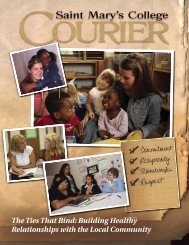Power Point
Power Point
Power Point
You also want an ePaper? Increase the reach of your titles
YUMPU automatically turns print PDFs into web optimized ePapers that Google loves.
EL PARAISO DELTRAFICANTE:A CONTENT ANALYSIS OF MUSICLYRICS IN NARCOCORRIDOSBy Mariela Aguilera
What is a Corrido? Narcocorrido? Corridos are songs which were sung in order todescribe the journey to the north, or the frontera, insearch of a better life. Corridos included themessuch as bravery, death, battle, and heartbreak. Over time, the growth of a more specific corridoevolved now known as the narcocorrido.
Thesis This study examined the lyrics of narcocorridos tobetter understand the ways the image of drugtraffickers have been constructed. The research studyrevealed unforeseen positive portrayals of drugtraffickers that would not have been necessarilyexpected to be found in such a social phenomenonsuch. Positive qualities included the following: fantasylifestyle, war-like violence, drug-trafficking persona,running the business, and reference to poorbackground.
Literature Review Narcocorridos Mirror Society Lifestyle Language Family/Faith in Narcotic Community
Theory Adorno theorizes about the economy and its role inthe music production Two forms of music:- Disenfranchised- music that is not part of thepopular mass music phenomenon because there is aclass distinction- Standardized- Adorno argues that over time, musichas become a standardized element of modernsociety: music is no longer unique but, rather, songsare derivative forms of art.
Methodology Latent content analysis Sample:- Searched for songs using the search engine knownas Google- Descriptive words were alternated or rearrangedboth in Spanish and English- Analyzed 31 randomly selected narcocorridos Coding- Open coding
Findings Fantasy lifestyle War-like violence Leadership Drug-trafficking persona Positive and negative characteristics Running the business Reference to poor background
Fantasy Lifestyle Coded in 28 out of the 31 songs Materialistic comforts Personalized weapons and cars Dressed in black with bullet-proof vests The party scene Women Travel for leisureLa Hummer de Sonoyta by El Tigrillo PalmaSon igual de enamoradosThey are very lovingY tienen mucho dineroSus gustos son las mujeresLas armas y carros nuevosAnd have a lot of moneyTheir tastes are womenWeapons and new cars
War-like Violence Coded in 27 out of the 31 songs Criminal behavior Combative environment Always prepared; always armed Send threatening or warning messagesComandos del MP by Voz de MandoAntiblindajeExpansivas las balasDos o tres bazookasY lanzagranandasObregon, Sonora deberas pensabaQue andaba en IrakAnti-armorThe bullets expandedTwo or three bazookasAnd grenadesObregon, Sonora really thoughtThat they were in Iraq
War-like Violence: Leadership Coded in 12 out of 31 songs Military type leadership Commander Obedience
The Drug-trafficking PersonaNegative characteristics Deceptive Willingness to kill See violence as innate Positive <strong>Power</strong>ful Courageous Proud Fearless Respected Calm Humble Wise Loyal
Running the Business In 17 out of the 31 songs, the lyrics depict drugtraffickers as having an organized and practicalway of running their business Aware of dangers Cultivate and work the land Emphasize the importance of keeping customerssatisfied Distribute drugs widely; crossingborders
Reference to Poor BackgroundFound in seven out of the 31 songsUsed to be mocked and pushed asideOvercame their obstacles and became successful drugtraffickersThey are now able to help their family, community, andguide those who wish to join the businessMusic VideoClave Privada by Banda el RecodoYa mucho tiempo fui pobreMucha gente me humillabaY empeza a ganar dineroLas cosas estan volteadasAhora me llaman patronI was poor for a long timeMany people humiliated meI began to earn moneyThe things are flipped nowNow they call me boss
Discussion Important to know more about because it isperpetrating fear; close proximity to the U.S. Adorno and his theory of the standardization ofmusic Consumerist culture Knit-tight community, motivation to join? Weaknesses and Strengths
Thank you!Questions?
ReferencesAdorno, Theodor W. 1976. Introduction to the Sociology of Music. New York: The Seabury Press.Alvarez, Robert R. Jr. 1995. “The Mexican- U.S. Border: The Making of an Anthropology of Borderlands.” Annual Review ofAnthropology 24: 447-470. Burr, Ramiro. 2003. “Narcocorrido Crackdown in Mexico Has Mixed Effect on Sales.” Billboard 115 (11): 28-31.Campbell, Howard. 2005. “Drug trafficking stories: Everyday forms of Narco-folklore on the U.S.- Mexico Border.” International Journalof Drug Policy 16: 326-333. Edberg, Mark C. 2001. “Drug Traffickers as Social Bandits.” Journal of Contemporary Criminal Justice 17(3): 259-277. Herd, Denise. 2009. “Changing images of violence in Rap music lyrics: 1979-1997.” School of Public Health 30(4): 395-406.Hernandez, Guillermo E. 1999. “What is a Corrido? Thematic Representation and Narrative Discourse.” Studies in Latin AmericanPopular Culture 18: 69-92. Herrera-Sobek, Maria. 1992. “Toward the Promised Land: La frontera as Myth and Reality in Ballad and Song.” Aztlán 21(1/2): 227-240. LaFranchi, Howard. 2001. “Mexican broadcasters take ‘narco-ballads’ off the air.” Christian Science Monitor. Retrieved March 29, 2011(http://web.ebscohost.com/ehost/detail?sid=513359db-045b-4cbd-a57a-2b913c84cffe%40sessionmgr13&vid=5&hid=9&bdata=JnNpdGU9ZWhvc3QtbGl2ZQ%3d%3d#db=aph&AN=4160399).Neuman, W. Lawrence.2007. Basics of Social Research: Qualitative and Quantitative Approaches. Boston, MA: Pearson EducationSaldaña, Johnny. 2009. The Coding Manual for Qualitative Researchers. Los Angeles: SAGE Press. Stavans, Ilan. 2002. “Trafficking in Verse.” The Nation 274(1): 41-45. Werner, Louis. 1994. “Singing the Border News.” Americas 46(6): 48.



